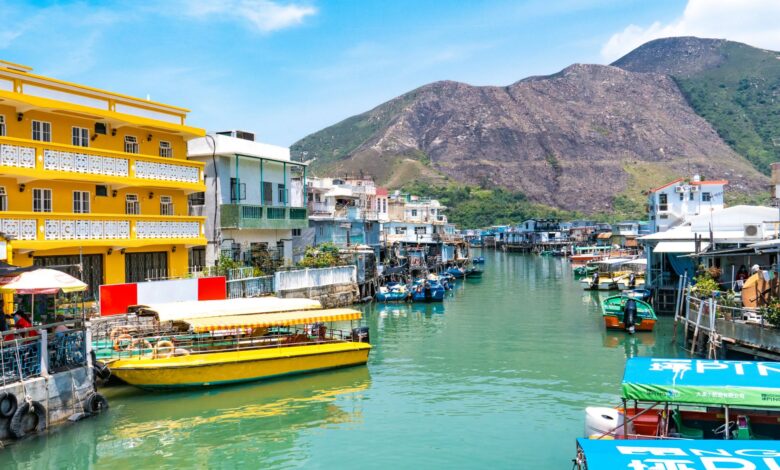
DDHK. ORG – Sunday, December 11, 2022 later DD Hong Kong together with Alibaba Holiday Limited held the Lantau Island Tour. For only HKD 200, this day trip visit Tai O Fishing Village or fishing village with exciting activities such as riding a bike boat, culinary, and sightseeing. Already know Lantau Island? Let's find out
The name Lantau Island is taken from the old local name of Lantau Peak. His Chinese name is sometimes romanized as Tai Yu Shan.
The island is historically known as Tai Hai Shan (大奚山), Tai Kai Shan (大溪山), Tai Yi Shan (大姨山) and Tuen Mun Island (屯門島).
Lantau Island (also Lantao Island, Lan Tao) is the largest island in Hong Kong. The island is located west of Hong Kong Island and the Kowloon Peninsula, and is part of the New Territories.
Administratively, most of Lantau Island is part of the Islands District of Hong Kong. A small part of the northeast of the island is located in the Tsuen Wan District .
Originally an island with fishing villages, it has been developed since the late 20th century with the construction of Tung Chung New Town on its northwest coast and the completion of several major infrastructure projects, including Lantau Link (1997), Hong Kong International Airport (1998) , Hong Kong Disneyland (2005), Ngong Ping 360 (2006) and Penny's Bay Quarantine Center (2020).
With a land area of 147,16 square kilometers (56,82 sq mi), it is the largest island in Hong Kong , almost twice the size of Hong Kong Island. Lantau Island mainly consists of mountainous areas.
Lantau Peak (934 meters (3.064 ft)) is the island's highest point. It is the second highest in Hong Kong, after Tai Mo Shan, and almost twice as high as Victoria Peak.
Other mountains include Sunset Peak (Tai Tung Shan) at 869 m (2.851 ft), Lin Fa Shan at 766 m (2.513 ft), Nei Lak Shan at 751 m (2.464 ft) and Yi Tung Shan at 747 m ( 2.451 feet).
Lantau Island is often referred to as the “lungs of Hong Kong”, due to the abundance of native forest and the relative scarcity of high-rise housing developments that characterize Hong Kong Island and Kowloon. Hong Kong's largest state park, Lantau South Country Park is located on the island, which houses two other parks, namely Lantau North Country Park and its extensions. These parks cover a little more than half the area of Lantau Island.
Shek Pik Reservoir is the third largest freshwater reservoir in Hong Kong. Completed in 1963, it covers an area of 1,01 km 2 (0,4 sq mi) and has a capacity of 24.500.000 m 3 (865.209.000 cu ft).
Lantau Island has a relatively low population density. Settlements are scattered throughout the island and each has its own characteristics. The completion of the Hong Kong International Airport at Chek Lap Kok in 1998 has brought economic development to the northwest of Lantau; the once quiet village of Tung Chung became a new town and is now home to more than 45.000 people located in 30 to 50 storey housing and condominiums located near the airport.
The adjacent Yat Tung estate accommodates 37.273 people, mainly in public housing. Over the next few years, the population of North Lantau New Town is expected to increase to a target population of over 200.000 on the 7,6 km 2 (2,9 sq mi) of reclaimed land stretching from Tung Chung to Tai Ho Wan.
Discovery Bay is a privately owned residential development located on the southeast coast of Lantau. The district has a population of 20.271 residents from more than 30 different countries, giving it a reputation as an expatriate enclave.
Ancient human artifacts have been found on the island. These include stone carvings at Shek Pik, which are thought to date to the Bronze Age, and stone circles at Fan Lau which may date to the Neolithic Age. Both sites are located on the southwest coast of the island.
The island is frequently featured on navigation maps due to its proximity to major sea routes in Southern China.
Lantau Island Tour
Here is the Tian Tan Buddha with Lantau Peak in the background, the stilt house (pang uk) in Tai O, the Yeung Hau Temple in Tai O built in 1699, and Ngong Ping.
The Ngong Ping Plateau features Po Lin Monastery and its vegetarian restaurant, as well as the 85-foot (26 m) bronze statue of the Tian Tan Buddha (or “Giant Buddha”), which was once the largest outdoor bronze Buddha in the world.
Hikers can climb from Tung Chung to the monastery in two hours. Visitors can also take the 360-minute Ngong Ping 25 ride from Tung Chung to the Ngong Ping Plateau. Ngong Ping 360 is a sightseeing experience that combines a 5,7 km cable car ride with a culturally themed village and easy access to the Tian Tan Buddha Statue.
While Tai O is a fishing village located in the northwest of Lantau Island which is more than three centuries old. Tourists visit Tai O for its several hundred houses on stilts ( pang uk ), although some of them have been repaired following a fire in July 2000 and others from damage caused by a super typhoon and associated storm surges in the following years.
Tai O retains most of its historical setting such as waterways, stilt houses and fishing boats and is famous for its views of fishing villages in the mountains. Traditional Chinese food such as locally produced salted fish and shrimp paste can be found there.
For Tung Chung Fort was built in 1817 to thwart the opium trade and defend the coast from pirates. There are 6 old cannons and the cover is made of granite . During World War II, Japanese soldiers occupied the fort. In 1979, it was listed as one of Hong Kong's historical monuments and renovated in 1988. The Tung Chung Battery Ruins , which is also a historical monument, are located nearby.
The Trappist Haven Monastery in Tai Shui Hang, home to a number of Roman Catholic monks, is located on the east coast of Lantau Island, roughly halfway between the towns of Mui Wo and Discovery Bay. The Lantau Trappist Congregation was founded in Beijing in the 19th century.
That is Lantau Island in all its beauty. [DDHK News]



